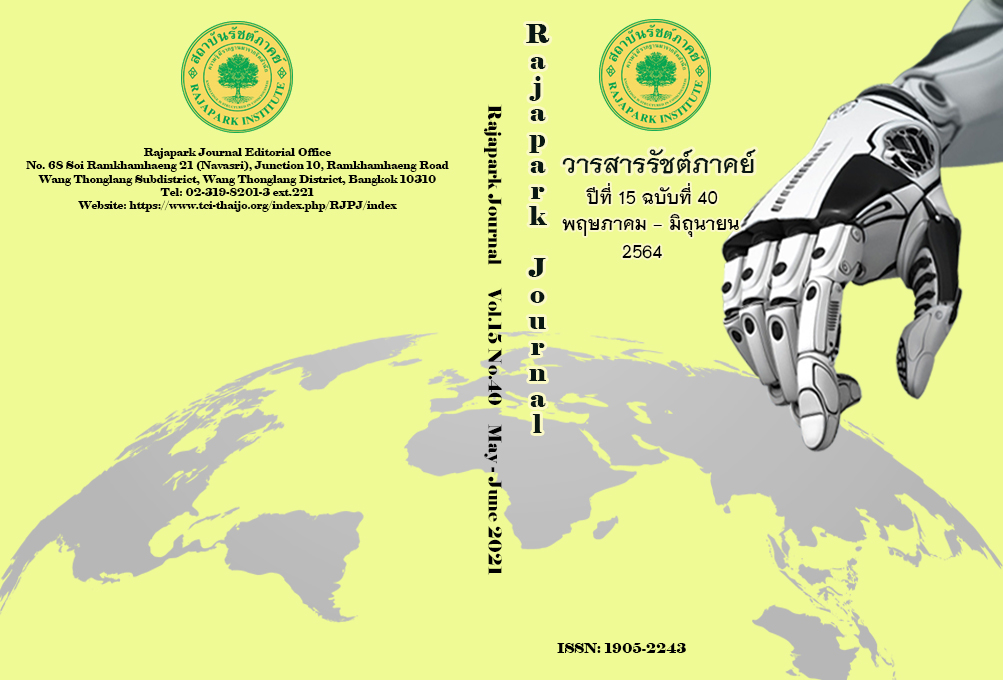ความสัมพันธ์ของการรับรู้ความสามารถของตนเองและแรงจูงใจในการทำงานกับประสิทธิภาพการปฏิบัติงานของพนักงานธนาคารแห่งหนึ่งในเขตกรุงเทพมหานคร
Main Article Content
บทคัดย่อ
การวิจัยนี้มีวัตถุประสงค์เพื่อศึกษาความสัมพันธ์ระหว่างการรับรู้ความสามารถของตนเองกับประสิทธิภาพการปฏิบัติงานของพนักงานธนาคาร และศึกษาความสัมพันธ์ระหว่างการรับรู้แรงจูงใจในการทำงานที่กับประสิทธิภาพการปฏิบัติงานของพนักงานธนาคารแห่งหนึ่งในเขตกรุงเทพมหานคร ประชากรที่ใช้ในการวิจัยนี้ คือ พนักงานของธนาคารแห่งหนึ่งในเขตกรุงเทพมหานคร กลุ่มตัวอย่างจำนวน 385 ตัวอย่าง โดยใช้แบบสอบถามในการเก็บรวบรวมข้อมูล และการวิเคราะห์ค่าทางสถิติ ได้แก่ สถิติเชิงพรรณนา ประกอบด้วย ค่าความถี่ ค่าร้อยละ ค่าเฉลี่ย และส่วนเบี่ยงเบนมาตรฐาน และทดสอบสมมติฐานด้วย แบบจำลองสมการโครงสร้าง โดยกำหนดนัยสำคัญทางสถิติไว้ที่ระดับ 0.05 ผลการวิจัยพบว่า แบบจำลองสมการโครงสร้างมีความสอดคล้องกลมกลืนกับข้อมูลเชิงประจักษ์ โดยพิจารณาจากค่า 2 เท่ากับ 176.969 p-value เท่ากับ 0.000
2/df เท่ากับ 1.770 GFI เท่ากับ 0.951 AGFI เท่ากับ 0.916 CFI เท่ากับ 0.984 NFI เท่ากับ 0.965 และ RMSEA เท่ากับ 0.045 ซึ่งผ่านตามเกณฑ์ตามที่กำหนดไว้ และผลการทดสอบสมมติฐานพบว่า การรับรู้ความสามารถของตนเอง และแรงจูงใจในการทำงานมีความสัมพันธ์ทางตรงเชิงบวกต่อประสิทธิภาพการปฏิบัติงานของพนักงาน อย่างมีนัยสำคัญทางสถิติที่ระดับ 0.00 โดยมีอำนาจในการพยากรณ์ร้อยละ 74
Article Details
ทัศนะและความคิดเห็นที่ปรากฏในวารสาร ถือเป็นความรับผิดชอบของผู้เขียนบทความนั้น และไม่ถือเป็นทัศนะและความรับผิดชอบของกองบรรณาธิการ
เอกสารอ้างอิง
Bandura, A. (1977). Self-Efficacy: The Exercise of Control. New York, NY: W.H. Freeman.
Bandura, A. (1986). Social Foundations of thought and Action. New Jersey: Prentice-Hall.
Bandura, A., O'Leary, A., Taylor, C. B., Gauthier, J., & Gossard, D. (1987). Perceived self-efficacy and pain control: opioid and nonopioid mechanisms. Journal of personality and social psychology, 53(3), 563-571.
Beattie, S., Woodman, T., Fakehy, M., & Dempsey, C. (2016). The Role of Performance Feedback on the Self-efficacy–performance Relationship. Sport, Exercise, and Performance. Psychology, 5(1), 1-13.
Cherian, J., & Jacob, J. (2013). Impact of self-efficacy on motivation and performance of employees. International journal of business and management, 8(14), 80-88.
Chienwattanasook, K., Pamornpathomkul, S., & Pholmamuang, V. (2019). Motivation and Organizational Climate Associating with Employee Performance: A Case of Sony Technology (Thailand) Co., Ltd. Journal of Management Science Nakhon Pathom Rajabhat University, 6(2), 36-49.
Chunhachinda, P. (2019). Digital Transformation and the Progress of Thailand’s FinTech. Suthiparithat Journal, 33(106), 251-261.
Digital Economy Promotion Agency. (2019). Crises and Opportunities for Bank Employees in the Digital Age. Retrieved May 17, 2020, from https://www.depa.or.th/th/article-view/bank-employees-in-the-digital
Engchuan, C., & Jadesadalug, V. (2017). The Influences of Job Autonomy-Openness to Experience Personality and Conscientiousness Personality-Perceived Self-efficacy on Effectiveness of Academic Performance. Electronic Journal of Open and Distance Innovative Learning, 7(1), 104-123.
Fornell, C., & Larcker, D. F. (1981). Structural Equation Models with Unobservable Variables and Measurement Error: Algebra and Statistics. Journal of Marketing Research, 18, 382-388.
Government Savings Bank. (2019). Banking Business. Retrieved May 17, 2020, from https://www.gsbresearch.or.th/wp-content/uploads/2020/01/IN_bank_12_62_detail.pdf
Hair, J., Black, W., Babin, B., & Anderson, E. (2010). Multivariate Aata Analysis (7th ed.). London: Pearson Education Limited.
Herzberg, F., Mausner, B., & Snyderman, B. B. (1959). The Motivation to Work (2nd ed.). New York: John Wiley & Sons.
Husain, U. K. (2014). Relationship between self-efficacy and academic motivation. In International Conference on Economics, Education and Humanities (pp.35-39). Bali: Indonesia.
Judge, T. A., Jackson, C. L., Shaw, J. C., Scott, B. A., & Rich, B. L. (2007). Self-efficacy and work-related performance: The integral role of individual differences. Journal of applied psychology, 92(1), 107-127.
Kalyanamitra, K. (2016). Two Powerful Motivation Factors to Success. Valaya Alongkorn Review, 6(3), 175-183.
Kavinphattharawach, P. (2014). Motivation Factors Influencing Performance Efficiency of Production Operators in Automobile Factory in Amata Nakorn Industrial Estate, Chonburi. Journal of interdisciplinary research: Graduate studies, 3(1), 261-282.
Kuranchie-Mensah, E. B., & Amponsah-Tawiah, K. (2016). Employee motivation and work performance: A comparative study of mining companies in Ghana. Journal of Industrial Engineering and Management, 9(2), 255-309.
Labbamrungwong, N. (2019). The Application of Motivation Theories in Performance of Work. Valaya Alongkorn Review, 9(2), 161-171.
Lestariningsih, M. (2017). Self-efficacy and achievement motivation on performance with perceived organizational support moderation (A study on private university lecturer with “A” Accreditation Kopertis Region VII East Java). In 2017 International Conference on Organizational Innovation (pp. 81-85). Atlantis Press.
Makki, A., & Abid, M. (2017). Influence of intrinsic and extrinsic motivation on employee’s task performance. Studies in Asian social science, 4(1), 38-43.
Peterson, E. & Plowman, G. E. (1989). Business Organization and Management. Ill: Richard D. Irwin.
Schunk, D. H. (1995). Self-efficacy, motivation, and performance. Journal of Applied Sport Psychology, 7(2), 112-137.
Sharpley, R. (2003). Tourism, tourists & society (3rd ed.). Huntingdon, England.
Sirited, P., Chamroonsawasdi, K., Pitikultang, S., & Yodmai, K. (2017). Effects of a life skills program on self-efficacy to prevent teenage pregnancy among female secondary school student in Ayutthaya province. Journal of Public Health, 47(3), 241-254.
The Standard. (2021). Transcript for 2020 Through the Bank's Statement: When banks fall, bad debts plunge and reserves are high, and debtors must be held together. Retrieved May 17, 2020, from https://thestandard.co/2563-lessons-through-bank-statements/
Thepho, C., & Luengalongkot, P. (2020). The Personnel Performance Efficiency Subdistrict Administrative Organization. Journal of Humanities and Social Sciences Bansomdejchaopraya Rajabhat University, 14(1), 251-265.
Vanichbuncha, K., & Vanichbuncha, T. (2015). Using SPSS for Windows to Analyze Data. Bangkok: Samlada printing house.
Yamane, T. (1973). Statistics: An Introductory Analysis (3rd ed.). New York: Harper and Row.


